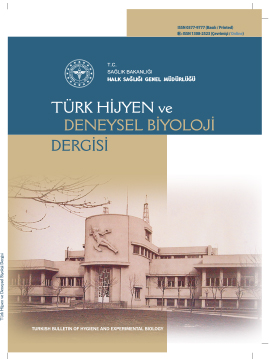
Bu eser Creative Commons Alıntı-GayriTicari-Türetilemez 4.0 Uluslararası Lisansı ile lisanslanmıştır.













Brucella perikarditi olgularının havuz analiz yöntemiyle değerlendirilmesi
Oğuz EVLİCE1, Mustafa YILMAZ2, Sevil ALKAN ÇEVİKER3, Uğur KÜÇÜK41Halk Sağlığı Genel Müdürlüğü, Bulaşıcı Hastalıklar Daire Başkanlığı, Ankara, Türkiye2İnfeksiyon Hastalıkları ve Klinik Mikrobiyoloji, Evliya Çelebi Eğitim ve Araştırma Hastanesi, Kutahya, Türkiye
3İnfeksiyon Hastalıkları ve Klinik Mikrobiyoloji, Çanakkale Onsekiz Mart Üniversitesi Tıp Fakültesi Çanakkale, Türkiye
4Kardiyoloji, Çanakkale Onsekiz Mart Üniversitesi Tıp Fakültesi Çanakkale, Türkiye
GİRİŞ ve AMAÇ: Bruselloz en sık görülen zoonotik enfeksiyon hastalıklarından biridir ve özellikle gelişmekte olan ülkelerde halk sağlığı sorunlarından biridir. Bruselloz sistemik semptomlara neden olabilmekte ve vücudun farklı bölgelerini etkileyebilmektedir. Brusella perikarditi kardiyovasküler sistemin seyrek görülen bir tutulumu olup bu çalışmada brusellozun perikardial tutulumunun klinik sonuçlarının araştırılması amaçlanmıştır.
YÖNTEM ve GEREÇLER: Dört uluslararası çevrimiçi veri tabanının tam metin ve özetleri “Brucella” ve “perikardit” anahtar kelimeleri ile tarandı. Olguların yaş ve cinsiyet, yayın yılı ve ülkesi, tanı yöntemleri, aldıkları tedaviler ve klinik sonuçları havuz analizi yönetemiyle incelendi. İstatistiksel değerlendirmede tanımlayıcı istatistikler kullanıldı.
BULGULAR: Çalışmaya yaş ortalaması 38.84 ± 9.7 (12-79) yıl olan 25 olgu (14 erkek, %56) dahil edildi. Hastaların 17 (%68)’sinde sistemik bulgular mevcuttu ve 17 ( %68)’si kardiyak belirtilerle başvurmuştu. On (%40) hastada retrosternal ağrı/göğüs ağrısı, 10 (%40) hastada perikardiyal frotman ve beş (%10) olguda taşikardi saptandı. En sık kullanılan tanı yöntemi serolojik testlerdi (%96) ve bunu kan kültürü pozitifliği takip ediyordu (%64). Rose Bengal testi yedi hastaya yapılmış olup altısında pozitifti. İyileşme 22 (%88) hasta için bildirilirken iki (%8) hasta kaybedilmişti.
TARTIŞMA ve SONUÇ: Bruselloz nadir görülen bir perikardit nedenidir ve özgün tedavi gerektirir. Bruselloz birçok gelişmiş ülkede sık görülmese de, endemik bölgelerde ayırıcı tanıda akılda tutulmalıdır. Standart tüp aglütinasyon testleri tanıda oldukça duyarlı ve özgüldür. Bu non-invazif, pratik test perikarditin ayırıcı tanısında kullanılmalıdır.
Evaluation of Brucella pericarditis cases by pooled analysis method
Oğuz EVLİCE1, Mustafa YILMAZ2, Sevil ALKAN ÇEVİKER3, Uğur KÜÇÜK41Department of Communicable Diseases, General Directorate of Public Health, Turkish Ministry of Health, Ankara, Turkey2Department of Infectious Diseases and Clinical Microbiology, Evliya Çelebi Training and Research Hospital, Kütahya, Turkey
3İnfeksiyon Hastalıkları ve Klinik Mikrobiyoloji, Çanakkale Onsekiz Mart Üniversitesi Tıp Fakültesi Çanakkale, Türkiye
4Department of Cardiology, Canakkale Onsekiz Mart University Faculty of Medicine, Canakkale, Turkey
INTRODUCTION: Brucellosis is one of the most frequent zoonotic infectious diseases and is a global public health concern, particularly in developing countries. Brucellosis causes systemic symptoms and can affect different parts of the body. Brucellar pericarditis is a rare involvement of the cardiovascular system. This study aimed to investigate the clinical outcomes of Brucella pericarditis cases.
METHODS: A pooled analysis study was conducted by searching four international online databases with the terms “Brucella” and “pericarditis” and their synonyms. The full texts or abstracts were screened using these keywords. The publications were examined in terms of the age and gender of cases, publication year and country, additional diagnosis, diagnostic methods, treatments, and outcomes.
RESULTS: The study included 25 cases (14 males, 56%), with a mean age of 38.84 ± 9.7 (12-79) years. Systemic findings were present in 17 (68%) patients, and 17 (68%) had a cardiac presentation. 10 (40%) patients had retrosternal pain/ chest pain, 10 (40%) patients had pericardial frontman, and five (%10) cases had tachycardia. The most commonly used diagnostic method was a serological test (96%), and a positive blood culture result was determined in 64%. The Rose Bengal test was performed in seven cases, of which six had positive results. Complete recovery was reported for 22 cases, and death in two patients.
DISCUSSION AND CONCLUSION: Although brucellosis is less common in many developed countries, it should be keep in mind differential diagnosis in endemic areas. Brucellosis is a rare cause of pericarditis and requires specific treatment. Standard tube agglutination tests are highly sensitive and specific in the diagnosis of brucellosis. This non-invasive, practical test should be used in the differential diagnosis of pericarditis.
Makale Dili: İngilizce
(481 kere indirildi)


